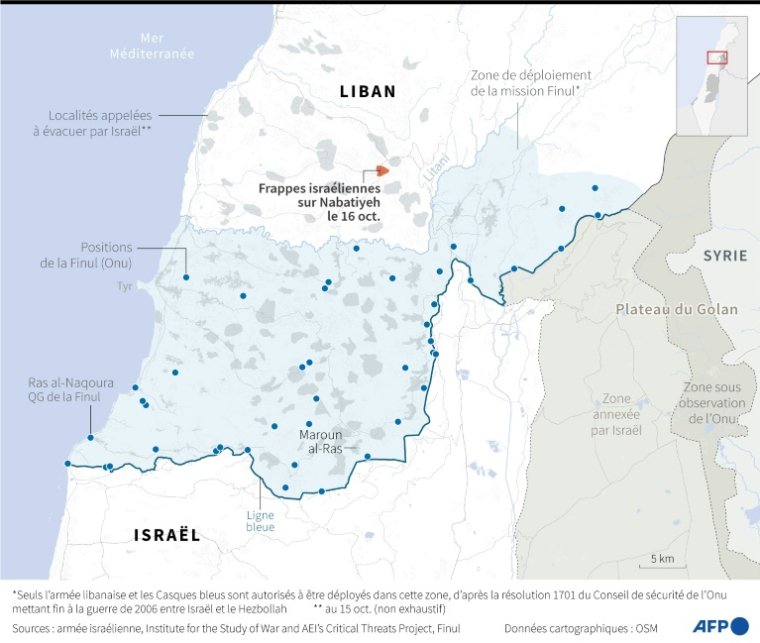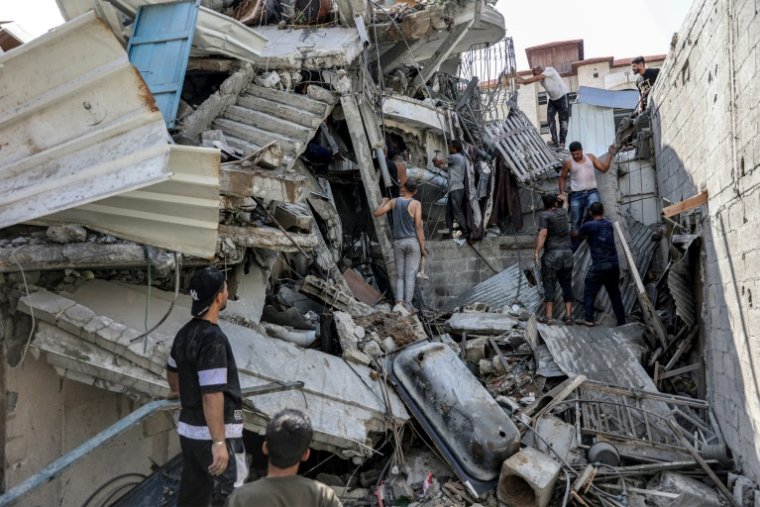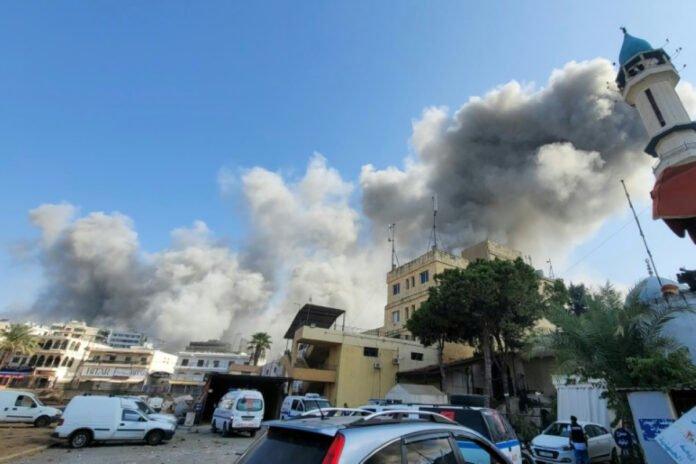Smoke rises in the town of Nabatiyeh after an Israeli attack, October 16, 2024 (AFP / Abbas Fakih)
The Israeli army carried out an air strike on the Syrian city of Latakia on Thursday, according to Syrian state media, and the United States bombed Houthi rebel positions in Yemen, nearly a month after the start of open war between Israel and pro-Iranian Hezbollah in Lebanon.
Iran, an ally of the Syrian regime, the Houthis, Hezbollah and Palestinian Hamas, for its part threatened on Thursday to “painfully” attack Israel if it hit targets “in Iran or in the region” in response to the missile attack. of Tehran on Israeli territory on October 1.
According to the Syrian Observatory for Human Rights (OSDH), an NGO based in London and with a large network of sources in the country, the operation against Latakia, the stronghold of President Bashar al-Assad, targeted “a weapons cache” of Hezbollah. It left two people wounded, according to the official Syrian news agency Sana.
While it carries out regular bombings against Syria, territory Hezbollah uses to transport weapons to Lebanon it says, the Israeli army rarely attacks this Syrian port city.
She urged the population on Thursday to evacuate an area of the Bekaa in eastern Lebanon bordering Syria, one of Hezbollah’s strongholds, which it has shelled since launching on September 23 massive bombings against the Lebanese Islamist movement.
The United States, for its part, announced that with B-2 stealth strategic bombers it had attacked five underground ammunition depots of the Houthi rebels, who control large parts of Yemen and have for months carried out attacks against Israel and the ships allegedly associated with them. to those linked to support for Hamas.
Israel and Washington carried out these operations the day after dozens of Israeli airstrikes in Lebanon, which the health ministry said killed 22 people, 16 of them in Nabatiyeh, including the city’s mayor.
In particular, the Israeli army indicated that it had targeted “dozens of Hezbollah targets” near Nabatiyeh in southern Lebanon, another Hezbollah stronghold, where it launched a ground offensive on September 30.
– “Painful” –
After weakening Hamas in Gaza, where the war sparked by the Islamist movement’s unprecedented attack on its soil on October 7, 2023 is still raging, Israel has shifted the bulk of its military operations to the Lebanese front against Hezbollah.
Israel also claims to be preparing its response to the October 1st Iranian attack.
“If you attack our targets, whether in the region or in Iran, we will hit you painfully again,” warned General Hossein Salami, head of the Revolutionary Guards, on Thursday during the funeral of a general from this ideological army of the Iranian regime . killed by an Israeli attack along with the former leader of Hezbollah, Hassan Nasrallah, at the end of September in Lebanon.
On Wednesday evening, the United Nations Peacekeeping Force (UNIFIL) deployed on the border between the two countries reported again “direct and visibly deliberate” Israeli fire against one of its positions.

Map of southern Lebanon showing in particular the UNIFIL (UN) deployment zone and the Israeli attacks on Nabatiyeh on October 16 (AFP / Nalini LEPETIT-CHELLA)
The White House had just reiterated its request to Israel “not to endanger the lives of civilians”, peacekeepers and Lebanese soldiers.
Hezbollah, for its part, claimed Thursday to have fired rockets targeting Israeli troops in a disputed border area near the Syrian Golan Heights annexed by Israel.
The day before, he had reported “violent melee” with Israeli soldiers near a border village in southern Lebanon and said he had fired a “rocket salvo” at Safed in northern Lebanon for the third time in 24 hours.
According to the army, “about 90 projectiles” were fired at Israel on Wednesday, slightly injuring four people, according to rescue workers.
Unicef described the destruction of at least “28 water supply facilities” as a “disaster for all children in Lebanon”, affecting “more than 360,000 people”, mainly in the south of the country, and exposing children to diseases such as cholera or hepatitis .
– “Not regretted” –
In nearly a month, at least 1,373 people have been killed in Lebanon, according to an AFP count based on official data. The UN has registered almost 700,000 displaced people.

Palestinians in Deir al-Balah in the central Gaza Strip on October 16, 2024 (AFP / Eyad BABA)
Israel says it wants to distance Hezbollah from its border and put an end to its incessant rocket fire since the start of the war in Gaza, to allow some 60,000 displaced people to return to northern Israel.
But despite the heavy blows inflicted on the Lebanese movement, its number two Naïm Qassem confirmed that he “will not be defeated” by Israel.
The “solution” to ending the war is “a cease-fire,” he reiterated.
– “Risk” of famine in Gaza –
In the besieged and devastated Gaza Strip, Israeli forces have been leading an offensive in Jabalia (north) since October 6, claiming that Hamas is trying to rebuild its forces there.

Destruction after an Israeli bombardment in Jabalia, in the northern part of the Gaza Strip, October 15, 2024 (AFP / Omar AL-QATTAA)
According to the head of the United Nations agency for Palestine refugees (UNRWA), Philippe Lazzarini, almost 400,000 people are trapped in the fighting in the area, where it “has become extremely complicated” to deliver humanitarian aid.
“Certain members of the Israeli government are using famine as a weapon of war,” he charged.
At least 42,409 Palestinians were killed, mostly civilians, in the Israeli retaliatory offensive in Gaza, according to data from the Hamas government’s health ministry, which the UN deemed reliable.
The October 7 Hamas attack resulted in the deaths of 1,206 people in Israel, most of them civilians, according to an AFP count based on official Israeli data and including hostages who died or were killed in captivity in Gaza.
